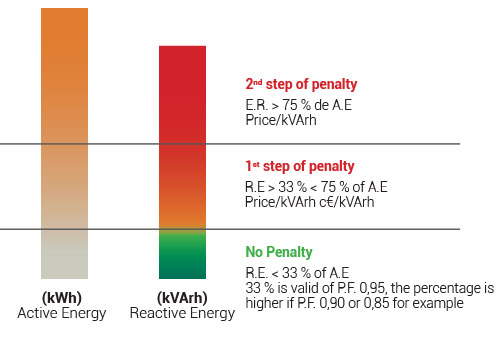Reduced energy costs
The installation of a power factor correction system inside a plant allows for immediate cancellation of the penalties for low Cos φ imposed by Energy Distributors.
Almost in all Countries worldwide, the Electric Utilities charge end users for excessive consumption of reactive energy, or Cos φ. There are many regulation since every Country imposes to respect its target P.F. (usually not less 0,90 but in some areas it’s required up to 0,98)
The reactive energy penalties are charged to applications with a minimum available power of «X» kW. For example in Italy start from 16,5 kW, while in others areas from 30 kW, or 50 kW until 1 MW; it depends from the regulation of each Utility.
The costs of penalties depends about the value of P.F. and the method appiedò from the Utility for the calculation. In Europe, the Utilities charge end users mainly with a fix price for each excessive kVArh consumed, compared to kWh consumption. In Africa, Asia ans South America, even if with different methods, the calculation is approximately the same, while in USA and Oceania are charged the extra kVA compared to kW.
The standard payback in major cases is inside the 12-18 months after PFC installation and not over 24 months.

The increase of the power factor with the consequent decrease of the current reduces voltage drops. Correcting the power factor and therefore reducing the current value with which electric transformers are charged, one moves away from saturation and therefore from operation in a non-linear zone, with a consequent reduction in the emission of harmonics.
The increased power factor also determines an increase of the Active Power (kW) available to Generator and Transformer terminals, since these machines, exempted from the burden of producing reactive power, can at minimum deliver as much active power as is their apparent power (kVA) by means of power correction.